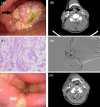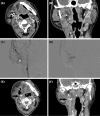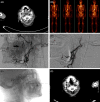Transcatheter arterial chemoembolization is safe and effective for patients with late-stage or recurrent oral carcinoma
- PMID: 35936680
- PMCID: PMC9353522
- DOI: 10.3389/fonc.2022.831583
Transcatheter arterial chemoembolization is safe and effective for patients with late-stage or recurrent oral carcinoma
Abstract
Objective: We reported the long-term outcomes of transcatheter chemoembolization (TACE) for patients with late-stage or recurrent oral carcinoma.
Methods: This retrospective study enrolled 18 patients with late-stage or recurrent oral carcinoma between December 2015 and April 2021. The tumor-feeding artery was catheterized, and cisplatin/oxaliplatin and 5-FU/raltitrexed were infused with embolization using polyvinyl alcohol or gelatin sponge. Computed tomography was performed at about 1, 3, and 6 months after the procedure, and every 6 months after that. During the procedure and follow-up, procedure outcomes, complications, treatment efficacy, and overall survival were analyzed.
Results: A total of 31 sessions of TACE were performed, with a technical success rate of 100%. Of 12 patients combined with oral hemorrhage, two patients showed rebleeding 35 and 37 days later, with a clinical efficiency of hemostasis of 88.9%. Mild complications were observed in 11 patients (61.1%). Severe complications or procedure-related deaths were not observed during or after the procedure. The objective response rate and disease control rate were 20.0% and 86.7%, 38.5% and 61.5%, and 25.0% and 50.0% at 1, 3, and 6 months later, respectively. Seventeen patients (94.4%) were followed up, with a median duration of 37.8 months (IQR 22.3-56.8). Nine patients died of tumor progression, one died of massive rebleeding, and one died of severe lung infection. The median overall survival was 23.8 months.
Conclusion: TACE is a safe and effective procedure with minimal invasiveness for treating late-stage or recurrent oral carcinoma. TACE can be recommended as a palliative treatment, particularly for patients with oral hemorrhage.
Keywords: TACE; complications; oral carcinoma; oral hemorrhage; oxaliplatin; raltitrexed.
Copyright © 2022 Bi, Du, Pan, Tang, Wang, Jiao, Han and Ren.
Conflict of interest statement
The authors declare that the research was conducted in the absence of any commercial or financial relationships that could be construed as a potential conflict of interest.
Figures



Similar articles
-
Clinical outcomes of doxorubicin-eluting CalliSpheres® beads-transarterial chemoembolization for unresectable or recurrent esophageal carcinoma.BMC Gastroenterol. 2021 May 21;21(1):231. doi: 10.1186/s12876-021-01816-3. BMC Gastroenterol. 2021. PMID: 34020608 Free PMC article.
-
Study of local three-dimensional conformal radiotherapy combined with transcatheter arterial chemoembolization for patients with stage III hepatocellular carcinoma.Am J Clin Oncol. 2003 Aug;26(4):e92-9. doi: 10.1097/01.COC.0000077936.97997.AB. Am J Clin Oncol. 2003. PMID: 12902905 Clinical Trial.
-
Gelatin sponge microparticles for the treatment of the spontaneous rupture of hepatocellular carcinoma hemorrhage.Exp Ther Med. 2016 Oct;12(4):2201-2207. doi: 10.3892/etm.2016.3573. Epub 2016 Aug 4. Exp Ther Med. 2016. PMID: 27698712 Free PMC article.
-
The safety and efficacy of balloon-occluded transcatheter arterial chemoembolization for hepatocellular carcinoma refractory to conventional transcatheter arterial chemoembolization.Eur Radiol. 2020 Oct;30(10):5650-5662. doi: 10.1007/s00330-020-06911-9. Epub 2020 May 15. Eur Radiol. 2020. PMID: 32409860
-
Transarterial chemoembolization for hepatocellular carcinoma after transjugular intrahepatic portosystemic shunt.Acta Radiol. 2012 Jun 1;53(5):545-50. doi: 10.1258/ar.2012.110476. Epub 2012 Apr 30. Acta Radiol. 2012. PMID: 22547388
Cited by
-
The safety and efficacy of TACE combined with HAIC, PD-1 inhibitors, and tyrosine kinase inhibitors for unresectable hepatocellular carcinoma: a retrospective study.Front Oncol. 2024 Jan 22;14:1298122. doi: 10.3389/fonc.2024.1298122. eCollection 2024. Front Oncol. 2024. PMID: 38318115 Free PMC article.
References
LinkOut - more resources
Full Text Sources
Miscellaneous

